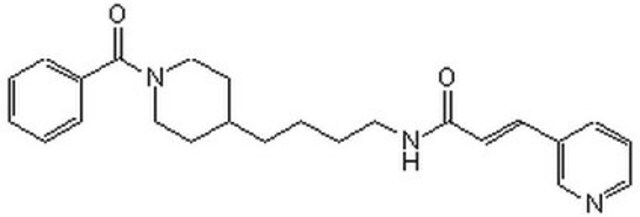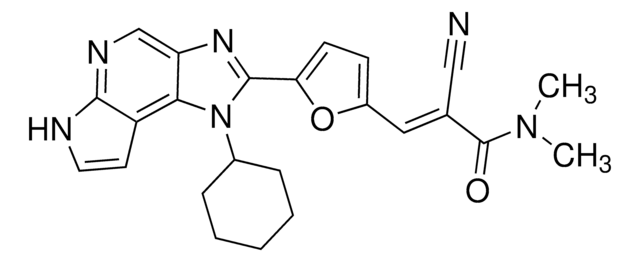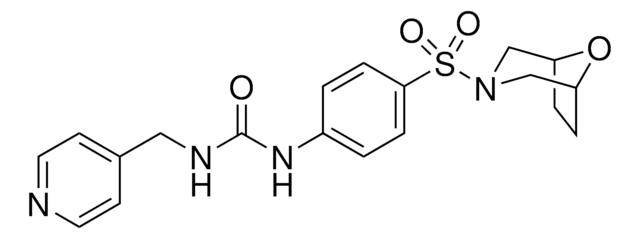Kluczowe dokumenty
D8446
P7C3
≥98% (HPLC)
Synonim(y):
3,6-Dibromo-a-[(phenylamino)methyl]-9H-carbazole-9-ethanol
About This Item
Polecane produkty
Próba
≥98% (HPLC)
Formularz
powder
kolor
white to off-white
rozpuszczalność
DMSO: 34 mg/mL
temp. przechowywania
2-8°C
ciąg SMILES
OC(CNc1ccccc1)Cn2c3ccc(Br)cc3c4cc(Br)ccc24
InChI
1S/C21H18Br2N2O/c22-14-6-8-20-18(10-14)19-11-15(23)7-9-21(19)25(20)13-17(26)12-24-16-4-2-1-3-5-16/h1-11,17,24,26H,12-13H2
Klucz InChI
FZHHRERIIVOATI-UHFFFAOYSA-N
Zastosowanie
Działania biochem./fizjol.
Degeneration of the hippocampus is an early manifestation of Alzheimer′s disease. P7C3 promotes neurogenesis in the subgranular zone of the hippocampal dentate gyrus, the site of normal neurogenesis in adult mammals, making it an important lead compound in development of new Alzheimer′s treatments.
Hasło ostrzegawcze
Danger
Zwroty wskazujące rodzaj zagrożenia
Zwroty wskazujące środki ostrożności
Klasyfikacja zagrożeń
Acute Tox. 3 Oral - Eye Dam. 1
Kod klasy składowania
6.1C - Combustible acute toxic Cat.3 / toxic compounds or compounds which causing chronic effects
Klasa zagrożenia wodnego (WGK)
WGK 3
Temperatura zapłonu (°F)
Not applicable
Temperatura zapłonu (°C)
Not applicable
Wybierz jedną z najnowszych wersji:
Certyfikaty analizy (CoA)
Nie widzisz odpowiedniej wersji?
Jeśli potrzebujesz konkretnej wersji, możesz wyszukać konkretny certyfikat według numeru partii lub serii.
Masz już ten produkt?
Dokumenty związane z niedawno zakupionymi produktami zostały zamieszczone w Bibliotece dokumentów.
Nasz zespół naukowców ma doświadczenie we wszystkich obszarach badań, w tym w naukach przyrodniczych, materiałoznawstwie, syntezie chemicznej, chromatografii, analityce i wielu innych dziedzinach.
Skontaktuj się z zespołem ds. pomocy technicznej










